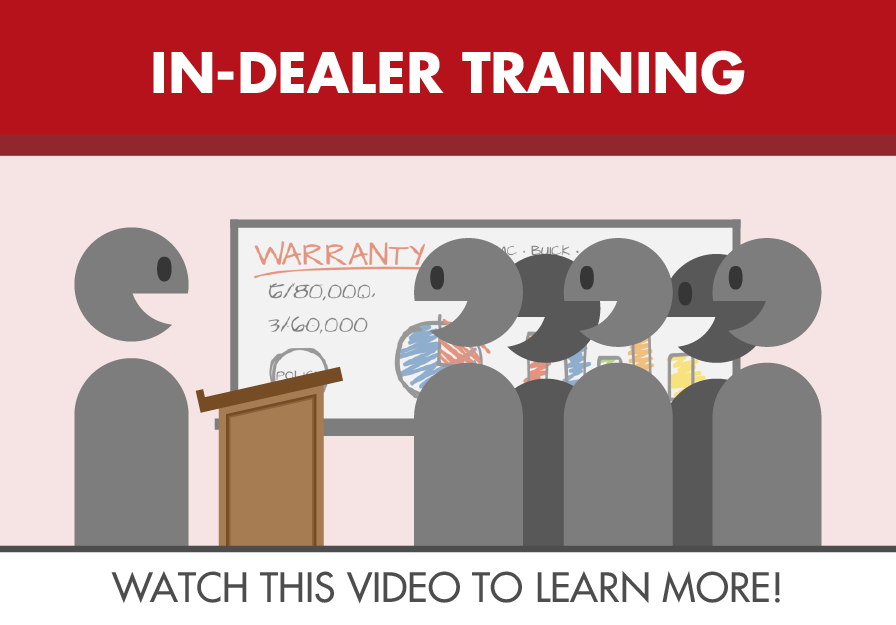What to do Before, During, and After an Audit
I. What to do Before an audit
Performing an internal “Audit Check”
As the dealer principal, how do you know if your service department is in compliance with the factory? A simple meeting with your service manager is not sufficient. Whether or not your service manager is aware that the department is deviant, it is not likely that you will be notified. Learn to be pro-active rather than waiting for a large charge back before making the necessary changes.
jlwarranty has devised the “Self Audit Checklist” so you can personally monitor and check your service department’s warranty job card compliance. These checklists include the primary points that auditors are keying on.
First, you will need to plan a meeting with all personnel involved with warranty. Then, using the “Self Audit Checklist,” personally go through each of the points and note the names of individuals who are ultimately responsible for checking each point. The checklist has been broken down into separate job categories to assist you. On your master copy you will document who is responsible for examining each point and list a follow-up date and action required, if necessary.
Check out jlwarranty's Self Audit Checklist to see if you're ready!
Next, randomly pull a few job cards (warranty and shop copies) from the previous month. Inspect each claim against the “Self Audit Checklist.” If one or more checkpoints are violated, the claim could result in a debit during an audit. Look for trends so you can find the root of the problem. For instance, if you are noticing the customer’s signature is not present on job cards, check the service advisor’s number or name on the job card and counsel that individual. Or if you notice that your technicians are not noting the necessary documentation (cause of failure, correction, specifications, etc.), plan a shop meeting to discuss those issues. You may want to have your service manager or warranty administrator present during your review in case you have any questions.
The key is the follow-up. Conduct your “review” monthly or bimonthly to make sure the appropriate changes are being made. No matter what is found on each review, a meeting should be held (with all service personnel attending) to focus on areas that need improvement and areas that have improved. Don’t expect what you don’t inspect.
Remember, if you have any questions feel free to call jlwarranty (800-852-6298). Don’t wait until it’s too late and you are faced with a costly chargeback. The manufacturers’ auditors may hand you a large charge back, but they can’t spend much time training you where you went wrong. If you continually “audit check” your service department, you decrease the chances of a large charge back substantially.
Audit Proofing Yourself
Analyzing factory statistical reports is an important management process. You must review areas of high expense and maintain a line of communication with the manufacturer. The factory provides reports concerning warranty expense, such as the 126, POPPS, and Service Agent Analysis Summary reports and reviews. These reports are sent out to dealers monthly for every franchise. Some dealer principals do not understand these reports or are unaware that they even exist. They should be taken seriously and analyzed extensively. The factory is actually showing you where you have potential problems and your dealership should be taking advantage of it. Find the root of each problem and make corrections to improve your expense trends.
Some manufacturers also send out self-reviews. Dealers are furnished a list of job cards to review for possible problem areas. The dealer then reviews each repair area and is given the opportunity to refund money to the manufacturer where appropriate. Always keep copies of all records when completed. These dealer self-reviews can be a warning sign. Don’t ignore them.
It is important that you have individuals on your staff that are knowledgeable with your manufacturer’s policies and procedures. This manual is generally updated and published every year. We often find that members of the service department have never heard of the service policy manual or don’t know where it might be found. It is our recommendation that you make it a requirement that all service staff read and be familiar with the sections in the manual that apply to them. Have employees sign a statement that they have read the applicable sections of the policy manual and have a clear understanding of it.
Make all dealership personnel aware that the dealer principal has an agreement with the manufacturer that states he or she agrees to properly administer all of the manufacturer’s policies and procedures as they stand. This is the dealer’s responsibility. The factory will hold dealers solely responsible for the validity and accuracy of all claims and in all matters pertaining to such claims. It’s the dealer’s responsibility to insure that this very important phase of their operation is conducted in a responsible, efficient, and effective manner.
“Friendly” Reviews
From time to time manufacturers will perform, or offer to perform a “friendly” audit, meant to be a learning experience. They will point out deviations and potential areas of concern. Be aware of these. They may lead to a return visit with sizable debits being made. On the other hand, they can be an important learning tool.
What to Expect When Notified
The factory will notify you by mail or phone that they will be conducting an audit and the date it will begin. You may be furnished a list of records that will be reviewed. If so, pull each claim and all supporting documentation before the audit begins.
Normally a factory audit involves corporate auditors, field staff, or possibly outside consultants. Audits can go back one year or beyond depending on the manufacturer and your state laws. Service and sales records can be reviewed, as well. If there are major problems found (i.e., dealership fraud) the audit could be extended to review beyond normal time limits.
One of the auditors is usually appointed as the “head auditor.” This individual will designate each of the auditor’s area of responsibility during the audit. The “head auditor” should be the main spokesperson with the dealership during the audit.
Original records should never be removed.
The information the auditors have at their fingertips is phenomenal. The auditor’s computers are loaded with an immense amount of information about your dealership. For instance, information can be obtained from insurance companies to check if warranty paint claims were performed on panels that had accidental body damage. The auditors can input a certain labor operation with a technician’s number and find out every time the tech performed that repair. If the tech is inefficient in that repair group, they can check that technician’s certification to see if it was appropriate to assign that job to him. If they don’t find what they are looking for, they can communicate with the factory online to gain more leads where they may find deviations.
Getting Ready
Prepare a pleasant room where the auditors can work that is well lighted and ventilated. This working area doesn’t need to be close to the service department. Auditors will be reviewing documentation, which should limit the disturbance to your office and technicians.
Some manufacturers will scrap your parts department. When you are notified that the audit is coming, it is important to inform the parts department. They should make sure their scrapping area is in order and that they will be able to easily retrieve any parts requested by the auditors. The parts scrapping area should be lighted and ventilated. Scrap parts that are beyond the date required to be held.
Have all new vehicles on the lot washed before the auditors come. If your service department has submitted claims for chemical paint spotting or buffing, auditors might note the condition of your new vehicle inventory. Be aware of manufacturers’ policies for battery replacement on stock vehicles.
The entire dealership should be aware that the auditors are coming. Inform your staff on which days the auditors will be in. All employees should treat the auditors courteously and act in a professional manner.
II. What to do During the Audit
What The Service Department Should Do
When the auditors arrive there should be an opening meeting to set agenda. Do not become offensive or defensive. Work with auditors so that your business will not be disrupted by their presence. Assign one person to the auditors through whom all requests for information and documents be made. This individual should be familiar with your filing system. This assigned person should only answer basic questions. During an audit, specific time limits could be set for a number of job cards to be pulled (example, one hour to retrieve 11 to 50 job cards with all associated records). It’s preferable not to let the auditors in your file cabinets. When they request information, politely tell them that you will retrieve anything they need.
Next, assign your warranty policy expert to the auditors. This person will most likely be your warranty administrator or service manager. This individual will handle all warranty questions and review debits. You do not want auditors talking to someone who doesn’t know or understand warranty policies and procedures. Ask auditors to review job cards on a daily basis, if possible. The person you assign should not be afraid to question an objectionable debit. Auditors might misunderstand a claim and this individual could offer clarification to the auditor, thus saving a potential debit. There might be situations where explanations can prove that the dealership did not purposely intend to submit the claim for false payment.
In some cases, only the part of the claim that cannot be supported can be charged back. For instance, if the auditor says an engine could have been rebuilt, they may only debit back the difference between replacement and rebuilding. If necessary, review and research the claim to determine validity.
If an auditor should call your customers, request that they let you be present in the room. You don’t want your customer to become concerned. In some cases the auditors will ask the customer to bring in their vehicle for a quality check, and may offer them a free service of some sort for their time. The auditor should not tell the customer that the reason they want to inspect the vehicle is for their audit. When the customer brings the vehicle in, have the service manager inspect the vehicle with the auditor. If the auditor completes the inspection and finds that repairs were not performed, the claim is subject to debit. Some auditors are equipped with paint thickness gauges to confirm that panels have been painted. Auditors, like all of us, can make mistakes. Don’t be afraid to question results.
What The Parts Department Should Do
Some manufacturer auditors will want to inspect warranty parts in your parts department. Some auditors will want to scrap your warranty parts. Make sure someone is present to offer explanations, if necessary during parts scrapping. Try to find any parts that may be missing and answer any of the auditor’s questions or concerns.
Auditors can take a production number from a part and cross-reference it with plant build data to find out what model/year the part was installed on at the factory. They are able to catch fraudulent claims submitted on the wrong VIN this way.
If the auditor debits back a claim because it was determined that the part was not defective or they felt it was the responsibility of the customer, hold that part until you confirm the validity of the debit, or reverse the debit. Don’t let the auditor throw away the parts that they make debits on.
When auditors are inspecting parts, they are looking for non-warranty defects. They will physically inspect parts that have been replaced due to cracks, tears, cuts, or that have been documented as broken. If it is determined that a part replacement should have been the responsibility of the customer, you could be charged back.
If the auditor debits a part as not defective, and you disagree (such as an intermittent module), inform the auditor that if debited, you will tag the part as “warranty use only” and return it to stock. The factory may end up paying for the repairs again which could result in an upset customer. This may cause the auditor to investigate the determination they made and alter the recommendation to debit that part.
The auditors can also check parts inventory. If the use of non-factory parts for warranty repairs is detected, your inventory will be checked to see if you meet stocking requirements. Auditors can also check factory parts purchases against outside purchases. Auditors may request documentation of warranty parts sales that were not from stock (lost sales), to prove that the repairs were actually performed. For instance, if during the last year you replaced 100 oxygen sensors and records only show that you purchased 50, you may have a problem.
Areas of Review
The auditors normally review three areas during a dealership audit.
A. “White” area - These are items the auditor reviews, finds nothing wrong, and then goes on to something else. The various items in this “White” area will probably not be discussed with the dealership representative. This may include areas where you are missing legitimate revenue.
B. “Black” area - These are items found by the auditor that are clearly deviant and will most likely result in a debit to the dealership. After review and discussion with your dealership representative, there will be an agreement that the procedure was not correct and the dealership will be debited. There should be no reason for the dealership to take exception to items in the “Black” area.
C. “Gray” area - There may be various items the auditor decides are not correct and would result in a debit, but when reviewed with the dealership representative, there is a possible difference in opinions. The dealer representative might offer a reason why the debit should not be issued, but the auditor still may feel the dealership is wrong and deserves the debit. In many manufacturers’ dealership audits, the “Gray” area is larger than the “Black” area. This is the area where dealership knowledge concerning policy becomes important. Some dealers may be charged back for items illegitimately. This is when you may want to call jlwarranty for professional help.
The Dealership’s Rights
Request that anything found subject to possible dealership debit be reviewed with the dealer and/or dealer’s designated representative (your policy expert) while the auditor is in the dealership. The dealer should request debit item reviews be done at a specific time, preferably on a daily basis. Auditors may try to do reviews either late in the afternoon or early in the morning. This can be a busy time for the dealership, so you will need to take appropriate time for adequate item-by-item review. Specify a time (i.e., mid day) when the dealership representative is able to thoroughly review each item and discuss them with the auditor.
Reviewing potential charge backs on a daily basis allows you to come up with missing documentation, call customers for verification, and obtain possible clarifications before the final decision to debit is made. If these potential charge backs are not reviewed daily by the dealership, it will be harder to reverse them when presented at the “exit” meeting at the end of the audit. You do not want any “surprises” at the closing meeting. It is also much easier to take exception to a possible debit verbally and face-to-face, than it is to get a reversal after the fact, when exceptions must be presented in writing and all paper documentation must stand on it’s own.
Do not get involved in heated arguments with the manufacturer’s auditor. Discuss all aspects of either a service or sales potential debit item with the idea of avoiding the debit. If the auditor is still convinced an item should be debited after discussion with the dealership representative, allow the debit to be listed, but remember the dealership always has the right to audit exceptions (will be discussed later in this special report).
Always strive to keep the total audit activity on the positive side. The dealer and dealership employees need to impress to the auditors that they are willing to let the audit activity be a learning experience. If there is a difference of opinions between the dealership and the auditor, suggest the dealership representative end discussion with the idea to “agree to disagree” regarding a potential debit item. Remember, the dealer always has the option of audit exception!
Sometimes, based on the early findings by the auditors, if dealership records appear to be in compliance with few potential debits found, the audit may be shortened. Part of the audit team may be sent to a different location.
Some manufacturers (like Ford) may offer to “extrapolate” their debit findings. For instance, they only audit six months of claims and find $10,000 to debit. They will ask you if you want them to come back and audit all claims for the past two years, or if you will except a chargeback based on extrapolation (in this case 2 yrs / 6 months = 4 x $10,000, or $40,000).
III. What to do After the Audit
Taking Exception
Upon conclusion of the audit, the auditor will arrange an “exit meeting” with the dealer and appropriate factory personnel to discuss the audit findings. Try to have this take place in your dealership. Have your most knowledgeable person, or a jlwarranty expert in the room with you. If you sign anything, do so only “with exception.”
All audit exceptions must be presented in a clear, logical way as to present your arguments and positions.
After the audit is completed, and the dealer is aware of the various manufacturer’s deviations and potential debits, there is normally a thirty-day “grace” period before the debit is actually issued to the dealership’s account. This period of time should allow the dealership to review the debit and decide if there is full agreement with all deviations and the potential debit. No matter what the dollar amount the debit might be, or the number of deviations from factory policy issued, the dealership always has the privilege of requesting an exception to the audit findings. Anytime the dealer has a difference of opinion related to the results of an audit, advising the factory of your intention to take exception is highly recommended.
Taking exception to the audit will accomplish the following for the dealership:
It is possible that the dealership will be able to present information to the factory that will support positive reasoning for a dealership claim and nullify the debit referring to specific items. If not nullify the debit, at least allow negotiation of a smaller debit than originally established. Audit debits are normally negotiable items between the dealer and factory. The field office will normally be supportive regarding the negotiations since they are reliant on the dealership for future activities.
Once the factory is notified of dealership intent to take exception, it will probably place the audit on a hold basis with no audit debits issued until the exception to the audit is resolved. Resolutions to the audit exceptions have been known to take lengthy amounts of time, thus delaying any debit. Also, exceptions that they do not settle in favor of the dealership can be appealed for reconsideration. Appeals to exceptions require additional time and negotiations for the final settlement of debit amounts.
Considering the reasons indicated above for taking exception to an audit, it is recommended the dealer seek advice from an independent consultant regarding audit deviations and debits. Also, remember that audit deviations are placed in factory records regarding the dealership. The dealership should consider having on record why the factory should not allow a particular deviation to be on file.
Don’t re-file claims the auditors have reviewed until after the results are issued and reviewed by the dealership to decide validity of the debits. If you need assistance in reviewing the auditor’s findings, contact jlwarranty. Our experts will go through each claim you question and give you our expert opinion. We will also show you where you might have missed revenue and help you submit the claims for reimbursements, when possible.
The Post Audit Process
Each manufacturer has specific post audit processes. If you are to take exception to the audit, you should have a written copy of your franchise’s policy. Following is a general procedure:
The dealer may request a post audit review meeting with the auditor and specific field office personnel. This request must be in writing. This meeting should take place within thirty calendar days of the “exit meeting.” In preparation for the meeting, the dealer should gather any documentation, which might refute audit findings.
Check with your state dealer association before this meeting to see if your state has franchise laws that limit the period for which the factory can make charge backs. For example, Illinois laws limit warranty audits to go back one year, while Virginia laws limit warranty audits to go back six months.
Within approximately thirty calendar days of the exit meeting, or the post audit review meeting, if held, a Preliminary Audit Report letter will be issued. If the dealer has further documentation that may change the findings conveyed in the Preliminary Audit Report letter, they normally have twenty calendar days following the date of receipt of the letter to request a review, or face-to-face meeting, with the appropriate Audit Process Manager at the manufacturers headquarters. With the request, the dealer must include all documents and arguments to be presented. If a meeting is requested, the dealer should be prepared to provide dates within the next thirty calendar days when they will be available to meet with the manager.
When the audit is final, the dealer will receive the Final Audit Report letter. The audit will be considered final, unless the dealer appeals. At this point, despite any subsequent appeal, the factory will bill any charge back on the dealer’s monthly open account. If the dealer does not request a review by the appropriate Audit Process Manager, they will presume that the dealer consented to the results of the audit contained in the Final Audit Report letter.
Audit Appeal
A dealer may file an appeal within thirty calendar days of receipt of the Final Audit Report letter. Contact jlwarranty for assistance. In your appeal, include a concise statement of the reason for the appeal, along with all relevant documents to support the dealer’s position. Arguments or documentation not originally presented in the appeal request won’t be considered.
If after the audit appeal there is no agreement, a final appeal is normally available with the head of sales for the manufacturer. The results of this appeal are usually issued at a meeting.
After the final appeal process the dealer’s next step would be to seek legal remedy under relevant state laws, or appeal to the state dealer board. These battles can be lengthy and costly.
Conclusion
The best way to prevent an audit is by strictly following factory policies and procedures. Let one of the jlwarranty experts come into your dealership to review and audit proof your dealership before you find out too late that policies and procedures weren’t being adhered to. We will also point out any areas of missed revenue. Our staff is here to help you. What jlwarranty charges can be far less than the factory would take in an audit. Remember, control your technicians, review expense trends with the factory on a regular basis, and leave the door open for communication.
jlwarranty offers In-Dealership Warranty Training! The most hands-on training option available: customized to meet your needs, at your dealership, and at your convenience. Call 1-800-852-6298.





